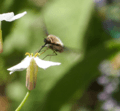Bombyliidae facts for kids
Quick facts for kids Bombyliidae |
|
|---|---|
 |
|
| Bombylius major | |
| Scientific classification |
|
| Kingdom: | Animalia |
| Phylum: | Arthropoda |
| Class: | Insecta |
| Order: | Diptera |
| Superfamily: | Asiloidea |
| Family: | Bombyliidae Latreille, 1802 |
| Subfamilies | |
|
|
| Synonyms | |
|
Phthiriidae |
|
The Bombyliidae are a large family of flies. They are usually called bee flies because many of them look a lot like bees.
There are hundreds of different types, or genera, of bee flies. But we don't know much about the life cycles of most of them. Some bee flies are very tiny, only about 2 mm long. Others can be quite large for a fly, with a wingspan of up to 40 mm.
Adult bee flies mostly eat nectar and pollen from flowers. Some have a very long mouthpart, called a proboscis. This helps them reach nectar deep inside flowers with long, narrow tubes. Bee flies are important pollinators for many plants.
Why do they look like Bees?
Many bee flies look like bees. This is why they are called "bee flies." They probably do this to protect themselves from predators. By looking like bees, which can sting, they trick animals that might want to eat them. This is a type of warning colouration.
Adult female bee flies usually lay their eggs near the nests of other insects. These often include the burrows of solitary bees, wasps, or beetles.
What about their Babies?
The young bee flies, called larvae, are special. They are either predators or parasitoids. This means they eat the eggs and larvae of other insects. When a bee fly egg hatches, the larva looks for a "host" insect. It then eats the host's eggs and larvae. Most bee flies are picky about their hosts. But some species can attack several different kinds of insects.
Images for kids
-
Two types of bee flies from Coimbatore, Tamil Nadu, India.
-
A bee fly in a conservatory in Hampshire, United Kingdom.
See also
 In Spanish: Bombílidos para niños
In Spanish: Bombílidos para niños
















